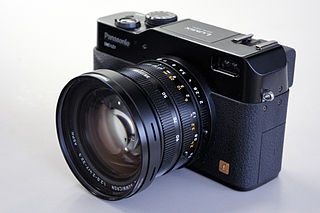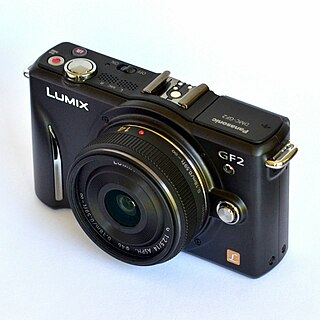The Leica Digilux 1 is a digital camera developed in partnership with Panasonic, which was released in 2002, roughly the same time as the Canon PowerShot G2 and the Nikon 2000. It is the second of Leica's digital offerings. Where the original Digilux was developed in partnership with Fuji Camera, the Digilux 1 was developed jointly with Panasonic; Leica is responsible for optics, while Panasonic designs the camera electronics. According to Leica, this allows both companies to design cameras that creates a harmonious matching of lens to sensor to produce color and contrast to Leica standards.

Lumix is Panasonic's brand of digital cameras, ranging from pocket point-and-shoot models to digital SLRs.

The Lumix DMC-L1 is Panasonic's first DSLR camera, and was announced in February 2006. This camera adheres to the Four Thirds System lens mount standard, making it the first non-Olympus Four Thirds camera, and thus confirming that the Four Thirds System is a semi-open standard such that compatible camera bodies can be built by different companies.

The Venus Engine is an image-processing engine for digital cameras. It is developed by the company Panasonic. Almost all of their Lumix cameras use a version of the Venus Engine. It is based on the Panasonic MN103/MN103S.

The Panasonic Lumix DMC-TZ3 was a compact 'Travel Zoom' camera announced on January 31, 2007. It was the successor to the 2006 TZ1 announced in 2006, and was released in parallel with the TZ2. It has a 10× optical zoom with the focal range equivalent to 28–280 mm coupled with Mega O.I.S. image stabiliser. It is a fully automatic compact camera, without manual control of aperture and shutter time. The TZ3 was awarded both the TIPA "Best Superzoom Digital Camera" award and the EISA "European Compact Camera" award in 2007. The TZ4, TZ5, and TZ50 succeeded the TZ2 and TZ3.
Panasonic Lumix DMC-FX150 is a digital camera by Panasonic Lumix. The highest-resolution pictures it records is 14.7 megapixels, through its 28-100mm Leica DC VARIO-ELMARIT.

Panasonic Lumix DMC-GF1 was introduced in September 2009 as the third camera in Panasonic's Lumix G-series, using the Micro Four Thirds system. It was the first model in the "GF" line, which is primarily distinguished from the other Lumix G cameras by the lack of an integrated electronic viewfinder.

The Olympus PEN E-PL2, was announced in early January 2011 at the CES. This is Olympus Corporation's fourth camera that uses the Micro Four Thirds mount after the Olympus PEN E-P1, Olympus PEN E-P2 and Olympus PEN E-PL1. At the time it was announced, it had a US dollar MSRP of $599.99. As with earlier PEN models, the E-PL2 is aimed in between the point-and-shoot and D-SLR markets.

Panasonic Lumix DMC-GF2 is the sixth camera in Panasonic's Lumix G-series, using the Micro Four Thirds System.

The Panasonic Lumix DMC-GH2 is a digital camera with HD video recording capability that is part of the Micro Four Thirds system. Though commonly referred to as a DSLR camera, it has no mirror or optical viewfinder, but has instead both a fold-out LCD screen and a electronic viewfinder.

Panasonic Lumix DMC-GF3 is the eighth camera in Panasonic's Lumix G-series adhering to the Micro Four Thirds System (MFT) design standard, and was announced in June 2011.

Panasonic Lumix DMC-FZ150 is a digital camera by Panasonic Lumix. The highest-resolution pictures it records is 12.1 megapixels, through its 25 mm Leica DC VARIO-ELMARIT. The camera was released for sale in the autumn of 2011. Its successor was the Panasonic Lumix DMC-FZ200.

Panasonic Lumix DMC-FZ200 is a digital camera by Panasonic Lumix, which was announced in July 2012. The highest-resolution pictures it records is 12.1 megapixels, through a 25 mm Leica DC Vario-Elmarit.

Panasonic Lumix DMC-LF1 is a digital camera by Panasonic Lumix. The highest-resolution pictures it records is 12.1 megapixels, through its 28 mm LEICA DC VARIO-SUMMICRON.
Panasonic Lumix DMC-SZ1 is a digital camera by Panasonic Lumix. The highest-resolution pictures it records is 16.6 megapixels, through its 25mm Wide-Angle Leica DC VARIO-ELMAR.
Panasonic Lumix DMC-TZ20, also known as Panasonic Lumix DMC-TZ22 or Panasonic Lumix DMC-ZS10, is a digital camera by Panasonic Lumix. The highest-resolution pictures it records is 14.1 megapixels, through its 24mm Ultra Wide-Angle Leica DC VARIO-ELMAR.
Panasonic Lumix DMC-TZ30 is a digital camera by Panasonic Lumix. The highest-resolution pictures it records is 14.1 megapixels, through its 24mm Ultra Wide-Angle Leica DC VARIO-ELMAR.
Panasonic Lumix DMC-TZ35 is a digital camera by Panasonic Lumix. The highest-resolution pictures it records is 16.1 megapixels, through its 24mm Ultra Wide-Angle Leica DC VARIO-ELMAR.
The Panasonic Lumix DMC-FS5 is a compact digital camera announced by Panasonic on January 29, 2008.

The Panasonic Lumix DMC-FZ300 is a constant-aperture DSLR-styled digital bridge camera announced by Panasonic on July 16, 2015. It succeeds the Panasonic Lumix DMC-FZ200.













